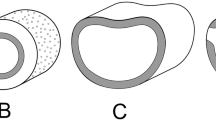Summary
This paper describes variations of a mode of stomatal development already described in a species (E. orbifolia) ofEucalyptus L'Herit. (Carr andCarr, Protoplasma 96, 127, 1978) in which the outer part of the stomatal pore (“ostiole”) is formed by the creation of a break in the thin layer of cuticle lying over the stomatal chamber. In a number of species with a thick cuticle (e.g., E. cooperana) the process of breakthrough is different: additions to the guard cell upper thickenings extend from them as ridges, pressing the leaf cuticle outwards. Breakthrough of the cuticle occurs above the tips of these extensions. The anterior chamber is lined throughout by the extensions, which become heavily cutinized. This mode of stomatal development is typical of many other species of eucalypts, including those dealt with in this paper.
In addition, inE. halophila thickenings develop on the end walls of the anterior chamber above the unusual upturned poles of the guard cells. Cutinized thickenings, “pseudo-outer stomatal ledges” are also formed on the upper guard cell walls. All these wall thickenings occlude the anterior chamber, leaving only a narrow passage in the form of a letter “H”.
Similar occlusions are found inE. balladoniensis but here the thickenings are developed into the chamber from its lateral walls. InE. gracilis, and the related speciesE. celastroides andE. calycogona, less regular occluding thickenings develop principally from the lateral walls of the chamber. In addition, large pseudo-outer stomatal ledges may be formed.
These phenomena are discussed in terms of the mechanism underlying the formation of the occluding thickenings and the possibility of their adaptive significance.
Similar content being viewed by others
References
Carr, D. J., Carr, S. G. M., 1978: Origin and development of stomatal microanatomy in two species ofEucalyptus. Protoplasma96, 127–148.
Carr, S. G. M., Carr, D. J., 1979: An unusual feature of stomatal microanatomy in certain taxonomically-relatedEucalyptus spp. Ann. Bot.44, 239–243.
— —, 1980: A new species ofEucalyptus from the margins of salt lakes in Western Australia. Nuytsia3, 1980 (in press).
Chippendale, G. M., 1977:Eucalyptus nomenclature. Aust. For. Res.7, 69–107.
Feder, N., O'Brien, T. P., 1968: Plant microtechnique: some principles and new methods. Amer. J. Bot.55, 123–144.
Napp-Zinn, K., 1973: Anatomie des Blattes, II. Angiospermen, A 1. In: Encyclopaedia of plant anatomy, Vol.8, Part 2 A. Berlin: Borntraeger.
Menz, J., 1910: Über die Spaltöffnungen der Assimilationsorgane und der Perianthblätter einiger Xerophyten. Öst. Akad. Wiss., Math.-Nat. Kl., Sitzungsber. Abt. 1119, 33–46.
Author information
Authors and Affiliations
Rights and permissions
About this article
Cite this article
Carr, D.J., Carr, S.G.M. Eucalyptus stomata with occluded anterior chambers. Protoplasma 104, 239–251 (1980). https://doi.org/10.1007/BF01279770
Received:
Accepted:
Issue Date:
DOI: https://doi.org/10.1007/BF01279770




